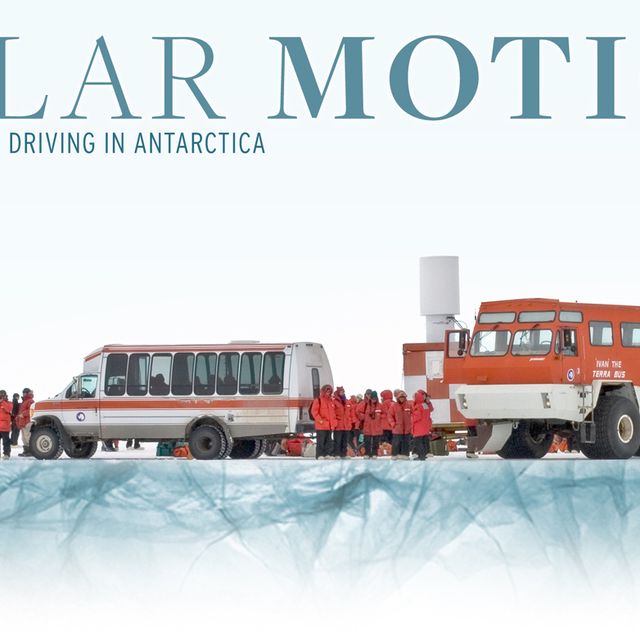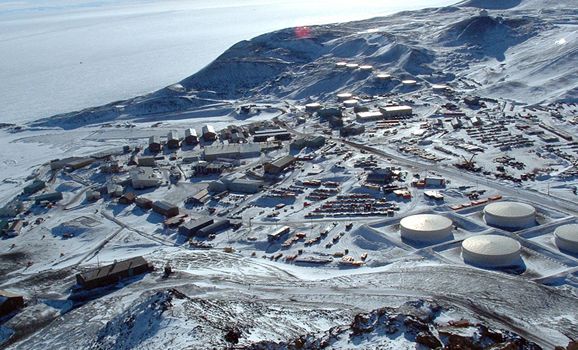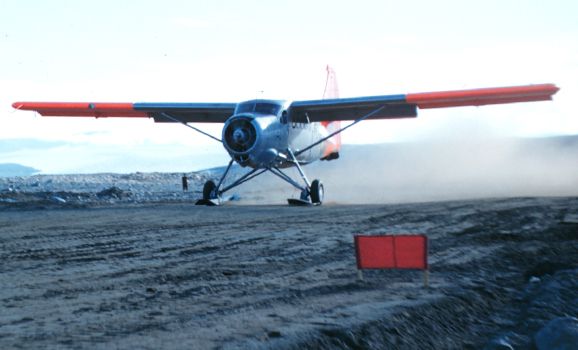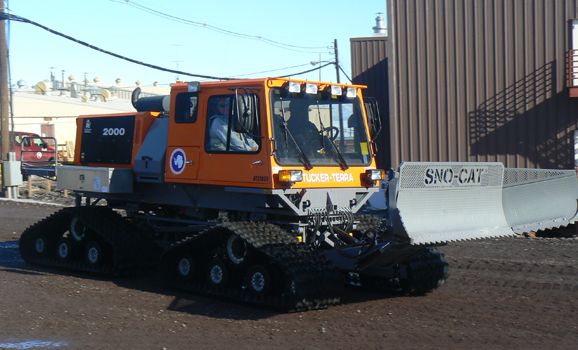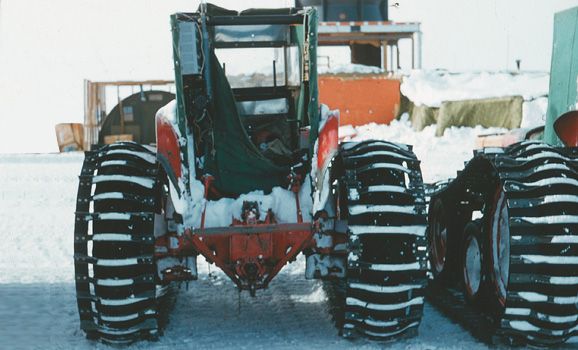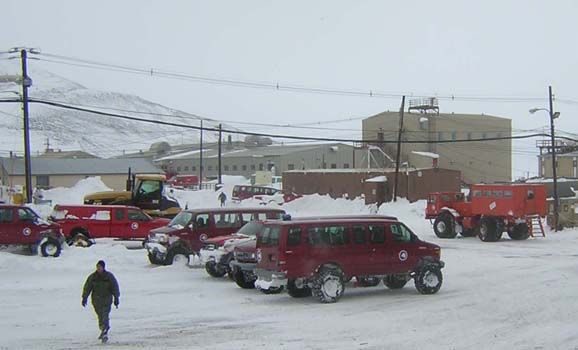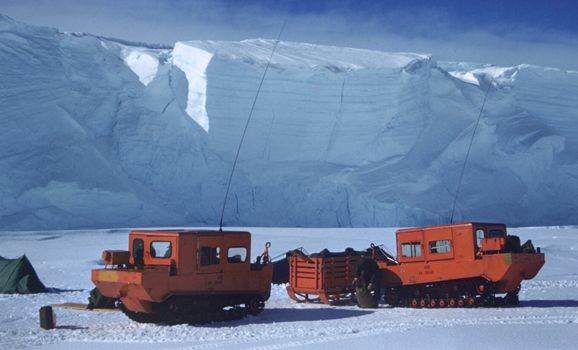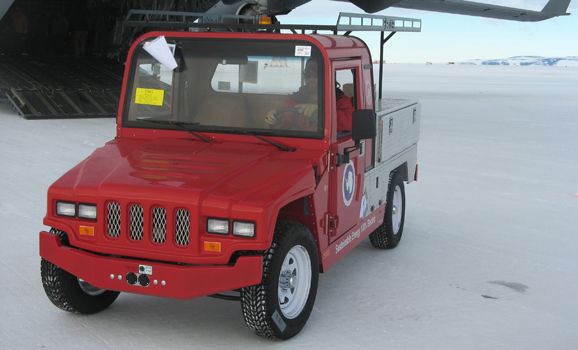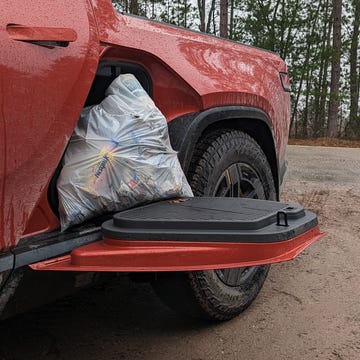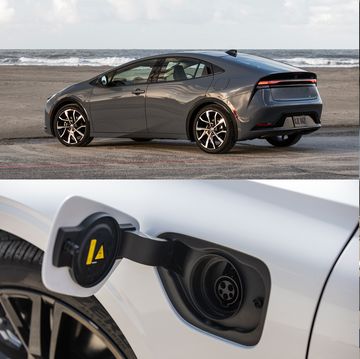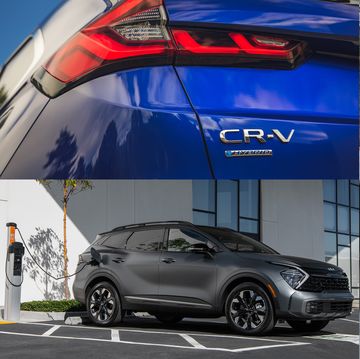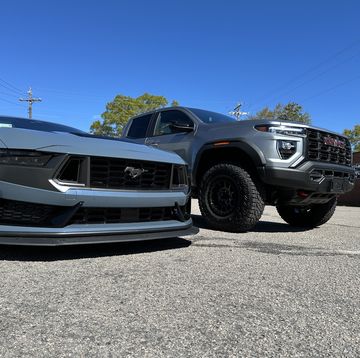It's the highest, driest, coldest, windiest, and emptiest place on earth. Ninety-eight percent of it is covered by ice, and at its deepest point, that ice is nearly three miles thick. It encompasses 5.4 million square miles of space, or almost two million square miles more than the continental United States. The mean annual temperature at its most populous outpost is a whopping 0 degrees Fahrenheit, and a South Pole winter can produce temperatures 100 degrees below that. Until being sighted in 1820–21, its existence was only a hypothesis, the stuff of cartographers' fever dreams.
And now people drive there.
At the risk of understatement, Antarctica is a hell of a place for a car. It's also a hell of a long way from anything else—McMurdo Station, the main U.S. ice station on the continent, is 2415 miles from the nearest populated city, which happens to be in New Zealand, which itself is a long way from anything. Getting a vehicle, let alone a person, to Antarctica requires careful timing, good weather, heaps of preparation, and several very long flights. And because conditions are so harsh, driving there is like driving on the moon. Maybe colder.
But people do it regularly. We recently stumbled onto the official U.S. Antarctic Program's fascinating photo archive, which in turn led us to this excellent image, which then made us wonder about the details. ("Ivan the Terra Bus"?) How long do cars and trucks survive at the South Pole? What does it take to get around in a land where the sun sets in late April and doesn't rise again for months? Above all, is it any fun?
To investigate, we called the National Science Foundation's Office of Polar Programs, which funds the country's Antarctic research presence. We spoke with George Blaisdell, the USAP's operations manager and a 22-year veteran with 28 trips to the ice under his belt. He's worked, lived, and driven in one of the world's harshest climates, and he has the stories to prove it.
First, a bit of background: You've spent a relatively large part of your life in Antarctica, but that can't be common. What's life like there?
Well, Antarctica's sort of like going to the space station—you don't go there for any other reason than work. My shortest visit was three hours; my longest deployment was 110 days. It really depends on your task. There are essentially two seasons, summer and winter, defined mostly by access. We can get to McMurdo Station from roughly the second half of August, when we start getting more than two hours of sun per day, until the middle of April, when the sun goes away again. With the pole, we can only fly there about 100 days a year. The cut-off temperature for our LC-130s is minus-50 Fahrenheit because of the hydraulic systems for the skis and doors. Smaller fixed-wing aircraft can operate at lower temperatures.
McMurdo is the continent's primary logistics hub. What are the driving conditions like?
Well, we run three permanent stations on the continent, two of which are on bedrock. The average snow thickness is about 8000 feet, and just two percent of the continent's mass is exposed—everything else is covered by ice and snow. So almost all our vehicles are designed to operate off-road. There are some gravel roadways suitable for pickups with oversized tires, but they're the exception, not the rule.
For the rest of what happens at McMurdo and everything at the South Pole, vehicles have to be capable of operating at ground pressures of less than 20 psi—ideally less than 5 psi, which usually means big tundra tires like you see on oilfield rigs. We have a few improved trails on snow and ice, but a lot of what we drive on is completely untouched terrain. The snow there isn't like the powder that falls in Colorado—it's windblown, with really low moisture content, and quite hard. If you kick it with your boot, you're likely to hurt yourself.
Nuts. What do most people end up doing behind the wheel?
Most of our vehicles are for moving materials or, to a lesser extent, personnel. We primarily move people by air, so we have a lot of vehicles for runway maintenance—large tractors on rubber tracks that tow large compactors or snow drags, that kind of thing. We move a lot of snow.
We have a [Foremost Terra Bus] that we use as an airport shuttle. It was originally built for the northern oil fields, with balloon tires seven feet in diameter and six feet across. We have customized, lifted 15-passenger vans running 40-inch bead-lock tires at 10 psi during the summer months when snow roads are at their weakest. The rest of the year they run at about 18 psi to reduce tire wear. We have 130 snowmobiles, 33 bulldozers, 52 tracked over-snow vehicles, 45 wheeled loaders, 30 rubber-tracked agricultural tractors (used for heavy over-snow towing), 28 heavy trucks, and 90 light trucks and vans…
…and serious mechanics.
It's nontrivial. We produce all our own power, and we make our own water with large diesel generators. Someone has to maintain that. We have heavy-equipment mechanics, light-equipment mechanics, snowmobile and chain-saw guys for cutting ice. But we try to do as little as possible down there. Keeping spares, and having anyone do anything there, comes at a premium. There's a lot of multitasking.
The first motorized vehicle in Antarctica was pioneered by Ernest Shackleton on the Nimrod expedition of 1907–09. He brought with him a 12- or 15-hp, air-cooled Arrol-Johnston car. It was pretty rudimentary and was a part of an attempt to figure out what worked best—skis, dogs, horses, or mechanical equipment. (You can still see mummified dog carcasses on the ice.) However, the car had neither the flotation nor traction required to operate in deep snow, and it hadn't been tested for the extremely low temperatures of Antarctica. After about 1910 or '11, the heroic age when Robert Falcon Scott and Edward Evans were doing their business, no one went back to the continent until the 1950s. It was virtually unoccupied. Edmund Hillary went to the South Pole with Ford Ferguson tractors that used belts between the front and rear wheels. He made a mad dash and actually beat Vivian Fuchs, who on the same expedition used Tucker Sno-Cats. But none of our machinery dates before that.
What's the average life span of heavy equipment there? The cold and conditions have to take a toll.
Nearly everything lasts longer than you'd think. There are two reasons for that: First off, we work intensely with a lot of equipment during the summer, but it's all parked for the winter. At the South Pole, a really high temperature might be 60 or 70 below, or it might be 80 or 100 below. A bulldozer sees about three months of intense use, in two 12-hour shifts. Then it sits idle for nine months.
The second part is the exceedingly clean environment. There's no sea spray, no smog, no bizarre chemicals in the air, no dust to speak of. You can have a bulldozer pushing huge quantities of snow—the resistance and the density are so much less than soil—without tapping into the capability of the dozer. Our dozers have specially designed blades that are 70 percent larger than normal blades. We're still running two bulldozers built in 1956. They're long in the tooth, and we have to manufacture parts, but it's common for us to get 20 to 25 years out of a vehicle that the manufacturer would list at 12 to 15.
What about vans and big stuff like the Foremost Terra Bus? Same principle?
Pickups and vans wear out closer to normal. They get the most use of anything we have—our light-vehicle fleet sees 3500 miles per year and averages 4 mph. They're used pretty hard, the way you would expect a contractor to use a truck, and we replace them roughly every seven years. For the rest of our fleet, we range between 400 miles for our ambulance to 13,000 miles for our civil works foreman's truck. You can't get around the environment. Winds get pretty high, and open doors can get caught in the wind and bent. Big stuff tends to move around in storms, garage doors and heavy things, and containers tip over and smash vehicles. There are times when everyone is contained indoors and the vehicles take a pounding.
The Foremost stuff was built for oilfield use in Canada and northern Alaska. There's still plenty of life left in those things. We've redone engines and such, but for the most part, it's plug and play—two long box beams for the chassis and giant Eaton axles hooked to it. It's a giant Lego [set].
So the vans are lifted, the oilfield vehicles are sturdy, and the production-based pickups are basically on the world's biggest, nastiest job site. Any Antarctic-specific modifications?
Well, we have extra heaters in a lot of things, for one. Permanent stations, where vehicles primarily hang out, get battery heaters, coolant heaters, transmission heaters, differential heaters. We have heavier vehicles that are drawing a kilowatt while plugged in because of the heating needs. For the bending doors, we use seatbelt material to create a strap from the door jamb to the door itself so they can't come close to the stops in high winds. Exhausts get covers to keep snow from blowing in. Heavy equipment gets custom air breathers and preheaters. We install manual parking-brake disconnects—there are manual locking valves in all the vehicle cabs—because it's far too easy for parking brakes to ice up and jam. Everything gets radios, obviously, as it all has to be prepped to survive on its own and let you call for help.
At those temperatures, fluids have to be a problem.
The light trucks and snowmobiles use Mogas, a military-grade, low-moisture gasoline; everything else runs on JP-5—similar to Jet A1—or AN-8, a unique kerosene with a low gel point of minus-53 degrees Fahrenheit. Every piece of equipment, from aircraft to generators to heavy equipment to snowmobiles and chain saws, operates on one of these three types of fuel.
Diesels aren't exactly the cleanest things out there, and that's a pretty sterile environment. Any plans to greenify the fleet?
We're working pretty hard to convert our vehicle fleet to electric power, at least where it makes sense. We already have two electric trucks down there—light vehicles built by Minnesota's E-Ride Industries. You see them a lot on university campuses. Fuel is a commodity, and our V-8s spend a lot of time idling. As mid-size trucks start to show up with electric or hybrid powerplants, USAP will be paying close attention to their potential. For each unit of fuel we burn in our powerplant, we get back 33 percent of that fuel's energy as electricity. We use heat exchangers to recapture as much of the remaining energy as possible to help heat a number of our buildings. At McMurdo, we capture a total of 85 percent as useful energy; at the South Pole, we believe we are closer to 95 percent. With our light-vehicle fleet, I estimate we only get back 10 to 15 percent of the fuel's energy content. With an electric truck, the power comes from batteries that are charged by our powerplant, which is harvesting eight times as much energy from our fuel as the internal-combustion engine does. For light electric vehicles, McMurdo's environment is ideal.
And now people drive there.
At the risk of understatement, Antarctica is a hell of a place for a car. It's also a hell of a long way from anything else—McMurdo Station, the main U.S. ice station on the continent, is 2415 miles from the nearest populated city, which happens to be in New Zealand, which itself is a long way from anything. Getting a vehicle, let alone a person, to Antarctica requires careful timing, good weather, heaps of preparation, and several very long flights. And because conditions are so harsh, driving there is like driving on the moon. Maybe colder.
But people do it regularly. We recently stumbled onto the official U.S. Antarctic Program's fascinating photo archive, which in turn led us to this excellent image, which then made us wonder about the details. ("Ivan the Terra Bus"?) How long do cars and trucks survive at the South Pole? What does it take to get around in a land where the sun sets in late April and doesn't rise again for months? Above all, is it any fun?
To investigate, we called the National Science Foundation's Office of Polar Programs, which funds the country's Antarctic research presence. We spoke with George Blaisdell, the USAP's operations manager and a 22-year veteran with 28 trips to the ice under his belt. He's worked, lived, and driven in one of the world's harshest climates, and he has the stories to prove it.
First, a bit of background: You've spent a relatively large part of your life in Antarctica, but that can't be common. What's life like there?
Well, Antarctica's sort of like going to the space station—you don't go there for any other reason than work. My shortest visit was three hours; my longest deployment was 110 days. It really depends on your task. There are essentially two seasons, summer and winter, defined mostly by access. We can get to McMurdo Station from roughly the second half of August, when we start getting more than two hours of sun per day, until the middle of April, when the sun goes away again. With the pole, we can only fly there about 100 days a year. The cut-off temperature for our LC-130s is minus-50 Fahrenheit because of the hydraulic systems for the skis and doors. Smaller fixed-wing aircraft can operate at lower temperatures.
McMurdo is the continent's primary logistics hub. What are the driving conditions like?
Well, we run three permanent stations on the continent, two of which are on bedrock. The average snow thickness is about 8000 feet, and just two percent of the continent's mass is exposed—everything else is covered by ice and snow. So almost all our vehicles are designed to operate off-road. There are some gravel roadways suitable for pickups with oversized tires, but they're the exception, not the rule.
For the rest of what happens at McMurdo and everything at the South Pole, vehicles have to be capable of operating at ground pressures of less than 20 psi—ideally less than 5 psi, which usually means big tundra tires like you see on oilfield rigs. We have a few improved trails on snow and ice, but a lot of what we drive on is completely untouched terrain. The snow there isn't like the powder that falls in Colorado—it's windblown, with really low moisture content, and quite hard. If you kick it with your boot, you're likely to hurt yourself.
Nuts. What do most people end up doing behind the wheel?
Most of our vehicles are for moving materials or, to a lesser extent, personnel. We primarily move people by air, so we have a lot of vehicles for runway maintenance—large tractors on rubber tracks that tow large compactors or snow drags, that kind of thing. We move a lot of snow.
Like any unique environment, Antarctica has its own rules. Because all operations at McMurdo are monitored by the U.S. government, those rules are published in a convenient and exhaustively detailed handbook. The U.S. Antarctic Program field manual has detailed instructions for everything from roped travel with snowmobiles in crevassed areas ("NOTE: Engine vibration can unscrew locked carabiners") to glacier travel with heavy machinery ("If you fall into a crevasse with a vehicle, kill the engine immediately to prevent carbon monoxide buildup in the crevasse and…subsequent poisoning"). In addition to being highly informative, the manual is a pretty entertaining way to kill a few hours.
At those surface pressures and outside temperatures, those jobs must require serious equipment…We have a [Foremost Terra Bus] that we use as an airport shuttle. It was originally built for the northern oil fields, with balloon tires seven feet in diameter and six feet across. We have customized, lifted 15-passenger vans running 40-inch bead-lock tires at 10 psi during the summer months when snow roads are at their weakest. The rest of the year they run at about 18 psi to reduce tire wear. We have 130 snowmobiles, 33 bulldozers, 52 tracked over-snow vehicles, 45 wheeled loaders, 30 rubber-tracked agricultural tractors (used for heavy over-snow towing), 28 heavy trucks, and 90 light trucks and vans…
…and serious mechanics.
It's nontrivial. We produce all our own power, and we make our own water with large diesel generators. Someone has to maintain that. We have heavy-equipment mechanics, light-equipment mechanics, snowmobile and chain-saw guys for cutting ice. But we try to do as little as possible down there. Keeping spares, and having anyone do anything there, comes at a premium. There's a lot of multitasking.
The Foremost Terra Bus might be the coolest bus on the planet. This monster snow-station school bus is built by a Canadian company that also produces tundra and oilfield support vehicles. The current-production Terra Bus carries 56 passengers, has a gross vehicle weight of 66,000 pounds, a maximum speed of 25 mph, and a 72-foot turning radius. It's 13 feet tall and sports a 250-hp Detroit Diesel four-cylinder. McMurdo's unit is charmingly nicknamed Ivan, as in "Ivan the Terra Bus."
The photo archive shows some pretty old machinery, some of which is still in use. How long have there been motor vehicles on the ice?The first motorized vehicle in Antarctica was pioneered by Ernest Shackleton on the Nimrod expedition of 1907–09. He brought with him a 12- or 15-hp, air-cooled Arrol-Johnston car. It was pretty rudimentary and was a part of an attempt to figure out what worked best—skis, dogs, horses, or mechanical equipment. (You can still see mummified dog carcasses on the ice.) However, the car had neither the flotation nor traction required to operate in deep snow, and it hadn't been tested for the extremely low temperatures of Antarctica. After about 1910 or '11, the heroic age when Robert Falcon Scott and Edward Evans were doing their business, no one went back to the continent until the 1950s. It was virtually unoccupied. Edmund Hillary went to the South Pole with Ford Ferguson tractors that used belts between the front and rear wheels. He made a mad dash and actually beat Vivian Fuchs, who on the same expedition used Tucker Sno-Cats. But none of our machinery dates before that.
What's the average life span of heavy equipment there? The cold and conditions have to take a toll.
Nearly everything lasts longer than you'd think. There are two reasons for that: First off, we work intensely with a lot of equipment during the summer, but it's all parked for the winter. At the South Pole, a really high temperature might be 60 or 70 below, or it might be 80 or 100 below. A bulldozer sees about three months of intense use, in two 12-hour shifts. Then it sits idle for nine months.
The second part is the exceedingly clean environment. There's no sea spray, no smog, no bizarre chemicals in the air, no dust to speak of. You can have a bulldozer pushing huge quantities of snow—the resistance and the density are so much less than soil—without tapping into the capability of the dozer. Our dozers have specially designed blades that are 70 percent larger than normal blades. We're still running two bulldozers built in 1956. They're long in the tooth, and we have to manufacture parts, but it's common for us to get 20 to 25 years out of a vehicle that the manufacturer would list at 12 to 15.
What about vans and big stuff like the Foremost Terra Bus? Same principle?
Pickups and vans wear out closer to normal. They get the most use of anything we have—our light-vehicle fleet sees 3500 miles per year and averages 4 mph. They're used pretty hard, the way you would expect a contractor to use a truck, and we replace them roughly every seven years. For the rest of our fleet, we range between 400 miles for our ambulance to 13,000 miles for our civil works foreman's truck. You can't get around the environment. Winds get pretty high, and open doors can get caught in the wind and bent. Big stuff tends to move around in storms, garage doors and heavy things, and containers tip over and smash vehicles. There are times when everyone is contained indoors and the vehicles take a pounding.
The Foremost stuff was built for oilfield use in Canada and northern Alaska. There's still plenty of life left in those things. We've redone engines and such, but for the most part, it's plug and play—two long box beams for the chassis and giant Eaton axles hooked to it. It's a giant Lego [set].
So the vans are lifted, the oilfield vehicles are sturdy, and the production-based pickups are basically on the world's biggest, nastiest job site. Any Antarctic-specific modifications?
Well, we have extra heaters in a lot of things, for one. Permanent stations, where vehicles primarily hang out, get battery heaters, coolant heaters, transmission heaters, differential heaters. We have heavier vehicles that are drawing a kilowatt while plugged in because of the heating needs. For the bending doors, we use seatbelt material to create a strap from the door jamb to the door itself so they can't come close to the stops in high winds. Exhausts get covers to keep snow from blowing in. Heavy equipment gets custom air breathers and preheaters. We install manual parking-brake disconnects—there are manual locking valves in all the vehicle cabs—because it's far too easy for parking brakes to ice up and jam. Everything gets radios, obviously, as it all has to be prepped to survive on its own and let you call for help.
At those temperatures, fluids have to be a problem.
The light trucks and snowmobiles use Mogas, a military-grade, low-moisture gasoline; everything else runs on JP-5—similar to Jet A1—or AN-8, a unique kerosene with a low gel point of minus-53 degrees Fahrenheit. Every piece of equipment, from aircraft to generators to heavy equipment to snowmobiles and chain saws, operates on one of these three types of fuel.
Diesels aren't exactly the cleanest things out there, and that's a pretty sterile environment. Any plans to greenify the fleet?
We're working pretty hard to convert our vehicle fleet to electric power, at least where it makes sense. We already have two electric trucks down there—light vehicles built by Minnesota's E-Ride Industries. You see them a lot on university campuses. Fuel is a commodity, and our V-8s spend a lot of time idling. As mid-size trucks start to show up with electric or hybrid powerplants, USAP will be paying close attention to their potential. For each unit of fuel we burn in our powerplant, we get back 33 percent of that fuel's energy as electricity. We use heat exchangers to recapture as much of the remaining energy as possible to help heat a number of our buildings. At McMurdo, we capture a total of 85 percent as useful energy; at the South Pole, we believe we are closer to 95 percent. With our light-vehicle fleet, I estimate we only get back 10 to 15 percent of the fuel's energy content. With an electric truck, the power comes from batteries that are charged by our powerplant, which is harvesting eight times as much energy from our fuel as the internal-combustion engine does. For light electric vehicles, McMurdo's environment is ideal.
